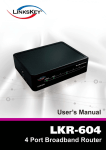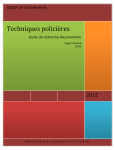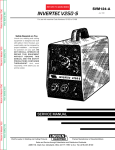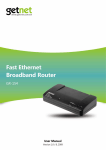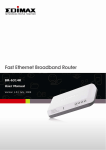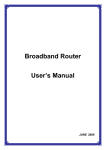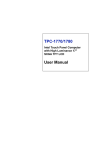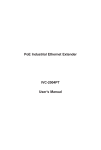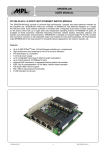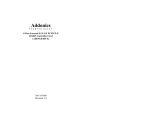Download Encore ENRTR-514 User`s manual
Transcript
ENRTR-514 Broadband Router User’s Manual ENRTR-514 User’s Manual FCC Warning This equipment has been tested and found to comply with the limits for a class B digital device, pursuant to Part 15 of the FCC Rules. These limitations are designed to provide reasonable protection against harmful interference in a residential installation. This equipment generates, uses and can radiate radio frequency energy and, if not installed and used in accordance with the instructions, may cause harmful interference to radio communications. However, there is no guarantee that interference will not occur in a particular installation. If this equipment does cause harmful interference to radio or television reception, which can be determined by turning the equipment off and on, the user is encouraged to try to correct the interference by one or more of the following measures: *Reorient or relocate the receiving antenna. *Increase the separation between the equipment and receiver. *Connect the equipment into a different outlet from that the receiver is connected. *Consult your local distributors or an experienced radio/TV technician for help. *Shielded interface cables must be used in order to comply with emission limits Notice Changes or modifications to the equipment, which are not approved by the party responsible for compliance could affect the user's authority to operate the equipment. Copyright 2010 All Rights Reserved. No part of this document can be copied or reproduced in any form without written consent from the company. Trademarks All trade names and trademarks are the properties of their respective companies. Copyright Encore Electronics © 2010. All Rights Reserved. -1- ENRTR-514 User’s Manual Contents: 1. Introduction ............................................................................................................... 4 1.1 Features........................................................................................................................ 4 1.2 Package Contents........................................................................................................ 5 1.3 LEDs Indication & Connectors of Broadband Router .............................................. 5 1.4 System Requirements ................................................................................................. 6 2. PC Configuration ...................................................................................................... 7 2.1 TCP/IP Networking....................................................................................................... 7 3. Setup Broadband Router Configurations via Web Browser ............................... 13 3.1 Start your Web Browser............................................................................................ 13 3.2 Quick Setup................................................................................................................14 3.3 Administrator ............................................................................................................. 15 3.3.1 Management................................................................................................... 15 3.3.2 System Settings............................................................................................. 16 3.3.3 Firmware Upgrade ......................................................................................... 17 3.3.4 Configuration ................................................................................................. 17 3.3.5 Tools ............................................................................................................... 18 3.3.6 Language........................................................................................................ 18 3.3.7 Log Settings................................................................................................... 18 3.3.8 Logout ............................................................................................................ 19 3.4 WAN ............................................................................................................................ 19 3.5 LAN ............................................................................................................................. 25 3.5.1 LAN Settings .................................................................................................. 25 3.5.2 DHCP Client List ............................................................................................ 26 3.6 NAT ............................................................................................................................. 27 3.6.1 Virtual Server ................................................................................................. 27 3.6.2 Port Triggering............................................................................................... 28 3.6.3 Port Mapping.................................................................................................. 29 3.6.4 Passthrough................................................................................................... 30 3.6.5 DMZ................................................................................................................. 31 3.7 Firewall ....................................................................................................................... 32 3.7.1 Firewall Options............................................................................................. 32 3.7.2 Client Filtering ............................................................................................... 33 3.7.3 URL Filtering .................................................................................................. 33 3.7.4 MAC Filtering ................................................................................................. 34 3.8 Routing ....................................................................................................................... 35 3.8.1 Routing Table................................................................................................. 35 -2- ENRTR-514 User’s Manual 3.8.2 Static Routing ................................................................................................ 35 3.8.3 Dynamic Routing ........................................................................................... 36 3.9 Misc............................................................................................................................. 36 3.9.1 UPnP ............................................................................................................... 36 3.9.2 DDNS .............................................................................................................. 37 3.10 Status........................................................................................................................ 37 3.10.1 Status............................................................................................................ 37 3.10.2 Log ................................................................................................................ 38 -3- ENRTR-514 User’s Manual 1. Introduction Congratulations on purchasing ENRTR-514 Broadband Router. ENRTR-514 is a high quality and reliable Internet routing device, enables multiple users to share the Broadband Internet connection through a Cable or DSL modem. You can simply install ENRTR-514, connect to Cable/DSL modem, and surf Internet without extra efforts. Acting as a 10/100Mbps 4-port Ethernet switch as well, the router, with all ports supporting MDI/MDIX, allows you to use CAT5 cable to uplink to other routers/switches. ENRTR-514 provides a total solution for the Small and Medium-sized Business (SMB) and the Small Office/Home Office (SOHO) markets, giving you an instant network today, and the flexibility to handle tomorrow's expansion and speed. 1.1 Features Internet Access Features ● Shared Internet Access: All users on the LAN can access the Internet through ENRTR-514 Broadband Router, using only a single external IP address. The local (private) IP addresses are hidden from external sources. This process is called NAT (Network Address Translation). ● DSL and cable modem Support: The Broadband Router has a 10/100BaseT Ethernet WAN port for connecting a DSL or cable modem. All popular DSL and cable modems are supported. ● PPPoE and PPTP Support: The Internet (WAN port) connection supports PPPoE (PPP over Ethernet) and PPTP (Point-to-Point Tunneling Protocol), as well as “Direct Connection” type services. ● Fixed or Dynamic IP Address: On the Internet (WAN port) connection, ENRTR-514 Broadband Router supports both Dynamic IP address (IP address is allocated on connection) and Fixed IP address. Advanced Internet Functions ● Conferencing & Telephony Applications: Internet Telephony and Conferencing applications are supported. ● DMZ: One PC on your local LAN can be configured to allow unrestricted 2-way communication with Servers or individual users on the Internet. ● URL Filter: Use the URL Filter to block access to undesirable Web sites by LAN users. -4- ENRTR-514 User’s Manual ● Internet Access Log: This feature is used to verify which Internet connections have been made. LAN Features ● 4-Port Ethernet Switch: The Broadband Router provides 4 10/100Base-T switching ports. ● Standard Compliance: The Broadband Router complies with the IEEE 802.3x full duplex flow control. ● DHCP Server Support: This feature provides a dynamic IP address to PCs and other devices upon request. The Broadband Router can act as a DHCP Server for devices on your local LAN. ● Multi Segment LAN Support: This feature is enabled through Broadband Router’s RIP (Routing Information Protocol) and build-in static routing table. Configuration and Management ● Easy Setup: Users allow to configure Broadband Router from anywhere on the LAN via web browser. ● Remote Management: The Broadband Router can be managed from any PC on the LAN. ● UPnP Support: Universal Plug and Play feature. UPnP is supported by Windows ME or later. Security Features ● Password Protected Configuration: Optional password protection is provided to prevent unauthorized users from modifying the configuration data and settings. ● NAT Protection: This feature allows all LAN users to share a single IP address and all users’ IPs are hidden. From the external viewpoint, there is no network only the Broadband Router exists. ● Firewall: All incoming data packets are monitored and all incoming server requests are filtered. 1.2 Package Contents ● One ENRTR-514 Broadband Router ● One External Power adapter ● One CD including user’s manual 1.3 LEDs Indication & Connectors of Broadband Router Front Panel LEDs Indication LED Light Status Description LED Light Status Description PWR On (Steady Green) ENRTR-514 is powered on. Off No power WAN On (Steady Green) WAN port is successfully connected Link/ACT Flashing Data is being sent or received. WAN On (Steady Green) WAN port is successfully connected to -5- ENRTR-514 User’s Manual 100Mbps 100Mbps Off WAN port is successfully connected to 10Mbps STATUS On (Steady Green) System is hung. Flashing ENRTR-514 is up and ready. LAN On (Steady Green) LAN port is successfully connected. (1, 2, 3, 4) Flashing Data is being sent or received. Reset On (Steady Green) When push the reset button on rear panel Off When release the reset button on rear panel Back Panel Connectors Button/port Description Button/port Description Reset Reset configurations to default. Press the button and hold for 10 seconds. 1x, 2x, 3x, 4x LAN Ports. Connect LAN systems with RJ-45 cable. WAN WAN port. Connect DSL or Cable modem. PWR Power jack. Connect with AC power adapter. 1.4 System Requirements ● Broadband connection and Cable/DSL modem ● Computers with wired network adapters ● CD-ROM Drive ● Operation System: Windows® 7/XP/2000, Windows Vista®, Mac® OS, UNIX®, Linux® ● Web Browser: Internet Explorer® 5.0, Firefox® 2.0 or Safari® 1.4 or higher -6- ENRTR-514 User’s Manual 2. PC Configuration User needs to configure TCP/IP network settings, Internet access configuration for each system within the ENRTR-514 Broadband Router’s LAN network. By default, the Broadband Router acts as a DHCP server for server version of Windows, it automatically assigns IP address to each system when systems boot up. For all non-server versions of Windows, the default TCP/IP setting acts as a DHCP client. If user chooses fixed IP addresses for client systems, the Gateway of the client system must be set to the proper IP address of the Broadband Router and DNS of the client system should be set to the address provided by your ISP. 2.1 TCP/IP Networking Checking TCP/IP Settings for Windows 2000 a) Select “Start Control Panel Network and Dial-up Connection” and right click “Local Area Connection” then click “Properties”, Your computer network device, could be Intel, Broadcom, Atheros or Realtek Ethernet controller Components depend on what service you installed before -7- ENRTR-514 User’s Manual b) Select the “Internet Protocol (TCP/IP)” for the network card on your system, then click “Properties”, window below will appear. ‧ If you decide to use IP address from the Broadband Router, select “Obtain an IP address automatically”. ‧ If you decide to use specific IP address, select “Use the following IP address”. Make sure enter correct addresses in “IP Address” and “Subnet Mask” fields. ‧ You must set the Broadband Router’s IP address as “Default Gateway”. ‧ If the DNS Server fields are empty, select “Use the following DNS server addresses” and enter the DNS address is provided by your ISP, then click “OK”. -8- ENRTR-514 User’s Manual Checking TCP/IP Settings for Windows XP a) Click “Start”, select “Control Panel Network Connection” and right click “Local Area Connection” then select “Properties”, window below will appear. -9- ENRTR-514 User’s Manual b) Select “Internet Protocol (TCP/IP)” then click “Properties”, window below will appear. ‧ If you decide to use IP address from the Broadband Router, select “Obtain an IP address automatically”. ‧ If you decide to use specific IP address, select “Use the following IP address”. Make sure enter correct addresses in “IP Address” and “Subnet Mask” fields. ‧ You must set the Broadband Router’s IP address as “Default Gateway”. ‧ If the DNS Server fields are empty, select “Use the following DNS server addresses” and enter the DNS address is provided by your ISP, then click “OK”. - 10 - ENRTR-514 User’s Manual Checking TCP/IP Settings for Windows Vista a) Click “Start” “Control Panel “Manage Network Connections” and right click “Local Area Connection” then select “Properties”, window below will appear. - 11 - ENRTR-514 User’s Manual b) Select “Internet Protocol (TCP/IP)” then click “Properties”, window below will appear. ‧ If you decide to use IP address from the Broadband Router, select “Obtain an IP address automatically”. ‧ If you decide to use specific IP address, select “Use the following IP address”. Make sure enter correct addresses in “IP Address” and “Subnet Mask” fields. ‧ You must set The Broadband Router’s IP address as “Default Gateway”. ‧ If the DNS Server fields are empty, select “Use the following DNS server addresses” and enter the DNS address is provided by your ISP, then click “OK”. - 12 - ENRTR-514 User’s Manual 3. Setup Broadband Router Configurations via Web Browser The ENRTR-514 4Ports Broadband Router comes with a web-based configuration utility. Users can access this configuration utility from any of client system within the Broadband Router’s LAN. For best results, either use Microsoft Internet Explorer 6.0 or later. Before you start configuring your Broadband Router, you have to get following information from your ISP: a) Has your ISP assigned you a static IP address, or they will assign one to you dynamically? If you have received a static IP address, what is it? b) Does your ISP use PPPoE? If so, what is your PPPoE username and password? If you are not sure of above questions, please contact your ISP immediately. 3.1 Start your Web Browser To use the Web-Based Utility, you have to launch your Internet Browser (MS IE 6.0 or later). Step1: Enter the Broadband Router default IP address http://192.168.0.1 in the Address field then hit Enter key: Step2: Login dialog box will appear, enter admin as User Name and default password is admin, then click “OK” to login web-based utility. - 13 - ENRTR-514 User’s Manual 3.2 Quick Setup Quick Setup will help you setup the ENRTR-514 Broadband Router quickly. There are six types of WAN Connections: Dynamic IP Address, Static IP, PPPoE, PPTP, L2TP, and BigPond. When configure the Quick Setup wizard, you can setup Host Settings, such as Host name, Time Zone, and Daylight Saving as below. Click “Next” to continue. After specify the WAN connection type required by your ISP, please follow the next steps to configure DHCP and DNS settings to complete the wizard. Dynamic IP address: Obtain an IP address automatically from your service provider. Static IP: Use Static IP address to access Network, your ISP should provide a static IP address already. PPPOE: PPPoE is a common connection type used for xDSL. PPTP: PPP Tunneling Protocol can support multi-protocol Virtual Private Network (VPN) L2TP: Layer 2 Tunneling Protocol can support multi-protocol Virtual Private Network (VPN) BigPond: BigPond is an Australian internet service provider and is a subsidiary of Telstra. - 14 - ENRTR-514 User’s Manual 3.3 Administrator 3.3.1 Management Use this page to restrict management access based on a specific password. Passwords can contain from 4-12 alphanumeric characters, and are case sensitive. Idle Time-out - The amount of time of inactivity before the Broadband Router will automatically close the Administrator session. Set this to zero to disable it. Default is 300. Remote Management - By default, management access is only available to users on your local network. However, you can also manage the Broadband Router from a remote host by adding the IP address of an administrator to this screen. Login Account: Allows you to setup a password in order to access the web-based management website. Remote Management: You can specify a Host IP address that can perform remote management functions. - 15 - ENRTR-514 User’s Manual 3.3.2 System Settings The System Settings window configures broadband router basic settings, such as router’s Host Name, Set Time Zone, Daylight Saving and Operation Mode. NTP Server (IP or Domain Name): Enter a Domain Name if it was provided by the ISP Time Zone: Select the time zone of the country you are currently in. The router will set its time based on your selection. Daylight Saving: The Broadband Router can also take Daylight savings into account. If you wish to use this function, you must check/tick the enable box to enable your daylight saving configuration. Host Name: Enter a hostname if it was provided by the ISP (Default: router). NAPT: You can select to enable NAPT function. - 16 - ENRTR-514 User’s Manual 3.3.3 Firmware Upgrade User uses the Firmware Upgrade window to locate the new firmware then upgrade the system firmware. Click Browse… to search for the new firmware location, and then click OK to precede the upgrade. 3.3.4 Configuration Use this window to restore or backup broadband router settings, such as Restore Factory Default, Backup Settings and Restore Settings. The Factory Default settings are: “Username: admin”, “Password: admin”, “IP: 192.168.0.1”, “Netmask: 255.255.255.0” - 17 - ENRTR-514 User’s Manual 3.3.5 Tools If for any reason the device is not responding correctly, you may want to restart the unit by clicking on the Reboot button. 3.3.6 Language Specify the language of the device menu. The two languages are supported in this router: English and Traditional Chinese. 3.3.7 Log Settings Not only does the device display the logs of activities and events, it can be setup to send these logs to specific location by IP address. The logs can be sent via email to a specific email account. SMTP Server: The address of the SMTP (Simple Mail Transfer Protocol) server that will be used to send the logs. Email Address: The email address the logs will be sent to. Click Email Log to send the email. - 18 - ENRTR-514 User’s Manual 3.3.8 Logout Click Logout in the task bar to initiate broadband router logout process. 3.4 WAN Specify the WAN connection mode required by your Internet Service Provider, then click "OK" Button to provide detailed configuration parameters for the selected connection type. - 19 - ENRTR-514 User’s Manual (a) Dynamic IP address Select this option if your ISP provides you an IP address automatically. This option is typically used for Cable services. Please enter the Dynamic IP information accordingly. DHCP: Obtain an IP address automatically from the ISP. MAC Address Clone: You can use the “Clone MAC Address” button to copy the MAC address of the Ethernet Card installed by your ISP and replace the WAN MAC address with this MAC address. (b) Static IP The IP address and Subnet Mask of Broadband Router can be seen by external user on the Internet (including your ISP). If your Internet connection requires a static IP address, then your ISP will provide you with a Static IP Address and Subnet Mask. IP address: IP address is given from your ISP. Subnet Mask: Enter the subnet mask of the Broadband Router. Gateway Address: Enter the Gateway address assigned by your ISP. MTU (576-1500): You can specify the maximum size of your transmission packet to the Internet. Leave it as it is if you to not wish to set a maximum packet size. - 20 - ENRTR-514 User’s Manual Does ISP provide more IP address: If your ISP supports more IP addresses, please check it. Otherwise, leave it blank. (c) PPPoE PPP over Ethernet is a common connection method used for xDSL. User Name and Password: Enter the User Name and Password you use when logging onto your ISP through a PPPoE or PPTP connection. Service Name: Optional. Input the service name if your ISP requires it. Otherwise, leave it blank. Maximum Transmission Unit (MTU): Most ISP offers MTU value to users. The most common MTU value is 1492. Maximum Idle Time: The amount of time of inactivity before disconnecting your PPPoE session. Set it to zero to disable this feature. Connect on Demand: Configure the Broadband Router to disconnect your Internet Connection after a specified period of inactivity (Max Idle Time). Connect on Demand enables the router to automatically re-establish your connection as soon as you attempt to access the Internet again. Keep-Alive option: Keeps you connected to the Internet indefinitely, even when your connection sits idle. - 21 - ENRTR-514 User’s Manual (d) PPTP PPP Tunneling protocol can support multi-protocol Virtual. PPTP: The Point-to-Point Tunneling Protocol (PPTP) is a method for implementing virtual private network. Server: Specify IP Address of the PPTP Server. IP Address and Subnet Mask: The private IP address and subnet mask would be assigned by your ISP. Connection ID: Optional. Input the connection ID if your ISP requires it. Otherwise, leave it blank. Maximum Idle Time: The time of no activity to disconnect your PPTP session. Set it to zero to disable this feature. If Auto-reconnect is enabled, this product will connect to ISP automatically, after system is restarted or connection is dropped - 22 - ENRTR-514 User’s Manual (e) L2TP Layer 2 Tunneling protocol can support multi-protocol Virtual. L2TP Mode: The Layer two Tunneling Protocol (L2TP) is a method for implementing virtual private network. Server: Specify IP Address of the L2TP Server. - 23 - ENRTR-514 User’s Manual (f) BigPond BigPond is an Australian Internet service provider and is a subsidiary of Telstra. User Name: Enter the User Name is provided by your ISP. This field is case-sensitive. Password: Enter the Password is provided by your ISP. This field is case-sensitive. Server IP: Enter the authenticating server IP address or host name. MTU: The normal MTU (Maximum Transmit Unit) value for most Ethernet networks is 1500 bytes. For some ISPs, you may need to modify the MTU. But this is rarely required, and should not be done unless you are sure it is necessary for your ISP connection. - 24 - ENRTR-514 User’s Manual 3.5 LAN 3.5.1 LAN Settings Configure the Gateway address of ENRTR-514 Broadband Router. To dynamically assign the IP address for client PCs, enable the DHCP Server, set the lease time, and then specify the address range. Valid IP addresses consist of four numbers, and are separated by periods. The first three fields are the network portion, and can be from 0-255, while the last field is the host portion and can be from 1-254. IP address: This is the router’s LAN port IP address (Your LAN clients default gateway IP address) Subnet Mask: Specify a Subnet Mask for your LAN segment. The Gateway acts as DHCP Server: You can enable or disable the DHCP server. IP Pool Starting Address: Enter the first address that should be assigned by the DHCP server. IP Pool Ending Address: Enter the last address that should be assigned by the DHCP server. Lease Time: Enter the number of hours that a client can use the assigned IP address. DNS Proxy: To enable or disable DNS Proxy (Domain Name Service). - 25 - ENRTR-514 User’s Manual 3.5.2 DHCP Client List The DHCP client list allows you to see which clients are connected to the Broadband Router via IP address, host name, and MAC address. You can select static to fix it. DHCP Client List: This page shows all DHCP clients (LAN PCs) currently connected to your network. The “DHCP Client List” displays the IP address and the MAC address and Remaining Time of each LAN Client. Use the Refresh button to update status. - 26 - ENRTR-514 User’s Manual 3.6 NAT 3.6.1 Virtual Server If you configure the Broadband Router as a virtual server, remote users accessing services such as Web or FTP at your local site via public IP addresses can be automatically redirected to local servers configured with private IP address. In other words, depending on the requested service (TCP/UDP port number), the Broadband Router redirects the external service request to the appropriate server. Enabled: Enable the Virtual Server option. Private IP: This is the LAN client/host IP address that the Public Port number packet will be sent to. Private Port: This is the port number (of the above Private IP host) that the below Public Port number will be changed to when the packet enters your LAN (to the LAN Server/Client IP) Public Port: Enter the service (service/Internet application) port number from the Internet that will be re-directed to the above Private IP address host in your LAN. Type: Select the port number protocol type (TCP, UDP or both). If you are unsure, then leave it to the default both protocols. Comment: The description of this setting. - 27 - ENRTR-514 User’s Manual 3.6.2 Port Triggering Some applications require multiple connections, such as Internet gaming, video conferencing, Internet telephony and others. These applications cannot work when Network Address Translation (NAT) is enabled. If you need to run applications that require multiple connections, specify the port normally associated with an application in the "Trigger Port" field, select the protocol type as TCP or UDP, then enter the public ports associated with the trigger port to open them for inbound traffic. Enable: Enable the Port Triggering function. Trigger Port: This is the out going (Outbound) range of port numbers for this particular application. Trigger Type: Select whether the outbound port protocol is “TCP”, “UDP” or “Both”. Public Port: Enter the In-coming (Inbound) port or port range for this type of applications (e.g. 2300-2400, 47624). Type: Select the Inbound port protocol type: “TCP”, “UDP” or “Both”. Comment: The description of this setting. - 28 - ENRTR-514 User’s Manual 3.6.3 Port Mapping This functionality allows one or more public IP addresses to be shared by multiple internal users. Enter the Public IP address you wish to share into the Global IP field. Enter a range of internal IP that will share the global IP. Enabled: Enable the Port Mapping function. Comment: The description of this setting. Server IP: Enter the NAT server IP address. Mapping Ports: Enter the port address NAT server maps to. Type: Select the Inbound port protocol type: “TCP”, “UDP” or “Both”. - 29 - ENRTR-514 User’s Manual 3.6.4 Passthrough Allow the Broadband Router correctly pass though the NAT gateway. [VPN] PPTP Passthrough: PPTP is a protocol that allows corporations to extend their own corporate network through private “tunnels” over the public Internet. Enable/Disable this protocol verification. IPSec Passthrough: IPSec is a framework for a set of protocols for security at the network or packet processing layer of network verification. L2TP Passthrough: L2TP is an extension to the Point-to-Point Protocol, which is an important component for VPNs. VPNs allow users and telecommuters to connect to their corporate intranets or extranets. [FTP] Non-Standard FTP Port (0-65535): If the FTP Server is using a non-Standard FTP port number, this can prevent FTP data connections from being established. - 30 - ENRTR-514 User’s Manual 3.6.5 DMZ If you have a client PC that cannot run Internet application properly from behind the NAT firewall or after configuring the Special Applications function, then you can open the client up to unrestricted two-way Internet access. Enter the IP address of a DMZ host to this screen. Adding a client to the DMZ (Demilitarized Zone) may expose your local network to a variety of security risks, so use this option only as the last resort. Enable: Enable/disable DMZ. (Default: Disable) Public IP Address: The IP address of the WAN port or any other Public IP addresses given to you by your ISP. IP Address of Virtual DMZ Host: Enter the DMZ host IP address. - 31 - ENRTR-514 User’s Manual 3.7 Firewall 3.7.1 Firewall Options The ENRTR-514 Broadband Router provides extensive firewall protection by restricting connection parameters to limit the risk of intrusion and defending against a wide array of common hacker attacks. However, for applications that require unrestricted access to the Internet, you can configure a specific client/server as a demilitarized zone (DMZ). - 32 - ENRTR-514 User’s Manual 3.7.2 Client Filtering You can filter Internet access for local clients based on IP addresses, application types, (i.e., HTTP port), and time of day. For example, this screen shows that clients in the address range 192.168.2.50-99 are permanently restricted from using FTP (Port 21), while clients in the address range 192.168.2.110-119 are blocked from browsing the Internet from Monday through Friday. - 33 - ENRTR-514 User’s Manual 3.7.3 URL Filtering URL Filtering feature allowing you to prevent users from accessing specified websites on the basis of some policies. Default is “Disable URL Filter Function”. 3.7.4 MAC Filtering The MAC address filer let user to allow or block certain client PCs accessing the Internet based on MAC address. MAC Address Control: This function allows user to determine whether to filter out or accept the following MAC address connect to Internet. MAC Address: Enter the MAC address to filter out or to accept. - 34 - ENRTR-514 User’s Manual 3.8 Routing 3.8.1 Routing Table The routing table displays the current routing information in system. 3.8.2 Static Routing A static route is a pre-determined pathway that network information must travel to reach a specific host or network. Destination LAN IP: The network address of destination LAN. Subnet Mask: The subnet mask of destination LAN. Gateway: The next stop gateway of the path toward the destination LAN. This is the IP of the neighbor router that this router should communicate with on the path to the destination LAN. - 35 - ENRTR-514 User’s Manual 3.8.3 Dynamic Routing Dynamic Routing can be used to cache routers learned by routing protocols, thus allowing the automation of static routing maintenance. The router, using the RIP (Routing Information Protocol) protocol, determines the network packet’s route based on the fewest number of hops between the source and the destination. In the working mode, router stands for normal rip router. Default gateway stand for router announces defaults route on both sides. Default is Disable. 3.9 Misc 3.9.1 UPnP UPnP (Universal Plug and Play) allows automatic discovery and configuration of equipment attached to your LAN. UPnP is by supported by Windows ME, XP, or later. It provides compatibility with networking equipment, software and peripherals of the over 400 vendors that cooperate in the Plug and Play forum. - 36 - ENRTR-514 User’s Manual 3.9.2 DDNS DDNS (Dynamic DNS) provides you on the Internet with a method to tie their domain name to a computer or server. DDNS allows your domain name to follow your IP address automatically by having your DNS records changed when your IP address changes. 3.10 Status 3.10.1 Status This status page displays the router’s current status and configuration. All information is read-only. - 37 - ENRTR-514 User’s Manual 3.10.2 Log The log file keeps a running log of events and activities occurring on the device. You may want to save the log files by clicking on Log Setting. When the device is rebooted, the logs are automatically cleared. - 38 -







































